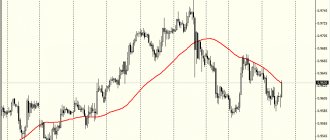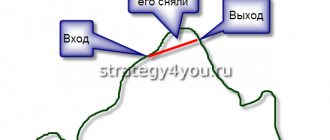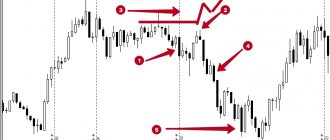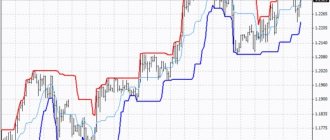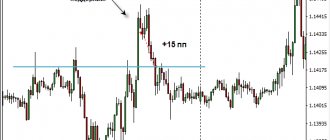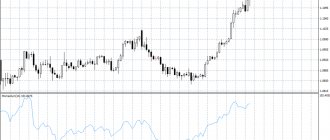In addition to general information, some indicators can give very specific signals to enter/exit the market and indicate successful points for concluding transactions.
What traders previously did for hours and manually can now be calculated automatically by a good indicator, correctly pre-configured and suitable for the trader’s trading style, conditions, currency pair, etc.
Main types of Forex indicators:
- Trend indicators – confirm/refute current market trends by highlighting discrepancies in charts and making effective forecasts.
Oscillators (inertial Forex indicators) are the most popular, they are simplified, they measure the magnitude and speed of price fluctuations, and analyze price behavior.- Psychological - they study the prevailing mood in the market, make predictions regarding the future actions of trading participants.
- Signal indicators are indicators that provide information regarding the market situation in the form of ready-made signals (hints for certain actions in the form of arrows).
- Volume – measure trading volumes.
- Hybrid – involve a combination of at least two instruments included in the standard set of the trading terminal.
- For binary options.
Custom ones are those that traders independently create and post publicly on the network (for free or for a certain amount).
The indicator is considered an auxiliary tool that can greatly facilitate a trader's performance of technical analysis. Based on indicators, many trading strategies, systems, and robots have been compiled. When trying to determine the best Forex indicator that exists today, each trader should focus on his trading style, preferences, conditions and other individual factors.
Before choosing an indicator, it is necessary to determine the following basic parameters: whether the instrument corresponds to the market, what its operating principle is (what it shows, why and how it calculates values), how the instrument is used in its work.
You should not trade with indicators whose operation principles the trader does not understand well - in this case, even the most accurate Forex indicators can cause losses, since any (even the most advanced) automatic system requires human participation and the ability to make their own decisions in difficult situations.
Many indicators are already pre-installed in the most popular trading terminals - for example, MetaTrader4/5 offers a fairly large selection of standard tools. In addition, many indicators are available on the Internet – free or for a fee.
The newest and best indicators 2021 from experienced traders, as a rule, cost a lot, but the likelihood of success with their use is higher, since they have already been tested in trading (which is supported by screenshots, examples), have descriptions and recommendations.
Before launching the indicator into trading, it is advisable to test it on historical data and evaluate its features, advantages and disadvantages.
Historical modeling does not guarantee 100% success in the future, but it often allows an adequate assessment of the quality of the tool’s performance. It is also important to find the optimal indicator settings in order to receive accurate signals for entering and exiting the market.
You should not try to use all the successful Forex indicators at once - an overloaded system will provoke delays in signals and may cause a conflict in indicators. It is better to settle on one, the most suitable tool and study it.
If you are going to use the Forex indicator in your work, you should not rely on it completely and consider it the only condition for profitable trading. The indicator only allows you to better understand the current situation on the market and indicates entry points.
But the tool will not prompt you with the following parameters:
- Optimal deal size.
- Acceptable losses in one transaction (risk management rules).
- How to manage all the transactions that a trader has the opportunity to open at once.
To build a trading system, you can take an indicator that provides timely and correct signals as a starting point. But to create filters for entry/exit points and determine capital management methods, you will need a whole system.
Exponential moving average
“Moving average” is the general name for a group of functions whose values at all points are equal to the average of the original function taken over the previous period. Typically, this type of instrument is used to smooth out short-term price fluctuations and highlight the main trends (cycles, trends). This is especially important in volatile markets.
The Exponential Moving Average allows you to reduce the lag by giving more weight to recent price values compared to more distant prices. This makes it possible to react more effectively to all current changes in value (compared to the standard moving average). The weight given to the last price value directly depends on the period of the moving average: the shorter it is, the more weight the last price has.
So, for example, a 10-period EMA gives the price a weight of 18.18%, a 20-period EMA gives it a weight of 9.25%.
It can be determined by two methods - in the form of a percentage moving average or a periodic one. In the percentage SS, the only parameter is the percentage (weight), in the periodic one, the period.
Basic formula: Here:
- i is the current moment;
- i-1 – previous point in time;
- K – equals 2/(n + 1), where n denotes the period of the average in bars.
Ways to change the period of an exponential moving average:
- By changing the coefficient K itself.
- By changing the moving period - in this case, the coefficient K is considered as 2/(1 + N), N is the set period.
So, for a 10-period EMA the coefficient will be as follows:
The EMA calculation uses all price indicators for the construction period, but over time the influence of old prices decreases and disappears. For shorter EMAs, old prices move away faster. On real charts, the difference between MA and EMA is not too big, but there is.
The exponential moving average more accurately reflects market prices, but tends to react very strongly to changes in value. Traders often use it for short-term trading in order to instantly catch the price. Here the choice is always between sensitivity and the desire to reduce the number of false signals. The more sensitive the indicator, the greater the number of false positives.
An exponential moving average takes a set of data and feeds the average price value, follows the price, works on all time periods. Typically, this indicator is used in combination with other instruments.
The main features of using EMA: use with other indicators and methods of technical analysis, use to determine the current trend and find places to set stop loss. EMAs can also be used as resistance/support zones in order to receive signals after the lines cross.
Example of an EMA strategy - EMA 50 (13 and 4) + Stochastic:
Setting up ADX in the MT4, MT5 terminal
In 99.9% of terminals the indicator is set as the basic one by default. To find it, go to: insert - then indicators - then trend indicators - select Average directional movement index.
If your terminal does not have it, then you need to install it.
Installation instructions:
- Download the archive, unzip it,
- Open the MT4 terminal, file – open data directory, mql4 – indicators,
- Copy the indicator file there, restart the terminal,
- We are looking for it in the section - custom.
Pay attention to the promotion from AMarkets
Open an AMarkets account
Trading with RSI
This indicator was created by stock trader Wells Wilder and published in June 1978 in Commodities magazine.
Later, the instrument was included in Wilder’s book, where he described the essence of the instrument in detail, and after that the indicator became very popular. RSI (stands for Relative Strength Index, translated as “relative strength index”) is an oscillator; it fluctuates in a certain zone defined by the minimum (0) and maximum (100) values. The tool displays “momentum” - the amplitude and speed with which the price moves, the force of its change in the direction of movement. That is, RSI helps determine the strength of a trend and the possibility of its change.
RSI indicator values:
- The more powerful the upward price movement (and the greater the total length of green candles over the n period), the closer the indicator value is to 100.
- The more powerful the downward price movement (and the greater the sum of the length of red candles over the n period), the closer the value is to 0.
The formula of the indicator is simple: it is based on the analysis of the closing prices of candles for an n period and their relative difference (when constructing a chart, only closing values are used, shadows of candles are not taken into account). The indicator shows the strength of price movement for a selected period of time, based on the strength of candles for this period.
Main signals of the RSI indicator:
- Overbought and oversold – the indicator reaches 70 and above (the asset is overbought, it’s not worth buying, it’s better to exit the deal and set a stop loss above) in anticipation of a trend reversal; an indicator below 30 indicates that the asset is oversold and there is a risk of selling it at the bottom.
- Determining the direction of the current trend - if the indicator crosses the value of 50, the trend changes, here the price often finds support/resistance. Often, during a downward trend, the price goes to the level of 20, and during an upward trend, to 80.
- Searching for support/resistance, trend lines - the classic rule of technical analysis works here. Breakouts of support/resistance and trend lines on the indicator often signal a future breakout on the price chart.
- Working out graphic patterns - when they are not on the price chart or are hard to see, the patterns can work well on the indicator chart.
- Search for divergence - when the values of the price and the indicator diverge: “bearish” is accompanied by an increase in price highs and a decrease in highs on the RSI, “bullish” - the price lows decrease and the indicator increases. Such situations indicate the possibility of a trend change.
To use the RSI indicator more effectively in your work, it is worth comparing its values on different timeframes (taking into account the values of the higher TF), the optimal period is 14 (a period of 14 candles), 9 and 25 are also popular. But it is worth remembering that the longer the period , the more noise there is in the graph.
Optimal values are 30 (oversold detection), 70 (overbought detection), 50 (trend search). But to search for a trend, 40 and 80 (upward trend), 20 and 60 (downward) may also be suitable.
Example of an RSI strategy:
Confirming a trend reversal using technical analysis patterns
Although it would probably be more accurate to say the opposite. After all, they usually first detect one or another pattern on the chart, and only then look for its confirmation using indicators. But this does not change the essence of the matter. In this case, we are exclusively interested in reversal patterns (these are patterns such as “Head and Shoulders”, “Double Top”, “Double Bottom” and others). The formation of a reversal pattern, as a rule, ends with the continuation of the price movement in the direction of the reversal. And a reversal signal from any of the indicators described above only strengthens this assumption.
An example of a trend reversal after the formation of a “Double Top” pattern
Read more about technical analysis patterns here.
Bollinger Bands indicator
The Bollinger Bands indicator (aka Bollinger Bands) is a technical tool that was created more than 30 years ago by financial analyst John Bollinger. The indicator is still relevant today; it is used to build a volatility channel, which allows you to determine the trend.
The Bollinger Bands tool uses the following parameters: the number of days for the moving average and the number of standard deviations. The most popular values are 2/2.5 standard deviations, which allow one to estimate volatility.
How to use the indicator:
- The curves narrow/widen in accordance with the strength of the movement in the market.
- As the curves approach one another, the market becomes stronger. Energy is released as soon as the chart breaks through the closing price of one of the extreme curves (standard deviations). If the upper curve is broken, it is a buy signal, and the lower curve is a sell signal.
- After a breakthrough has occurred, the movement will be close to the broken line.
- If during a correction the market reaches SMA20, this is a signal to add positions, because the moving average here acts as support (buy) or resistance (sell).
- It is worth closing trading positions when the market breaks through the SMA20 at the closing price. This happens because if, when touching one curve (upper/lower), the market pushes away from it and breaks through the middle curve, it will definitely reach the opposite curve. For example, if the market reaches the upper curve, returns and crosses the closing price level of SMA20, then it returns and reaches the lower curve.
An example of a strategy on the indicator - Bollinger on steroids:
Account Equity Analyzer v2
This indicator is one of the simplest in our set; it performs only the most necessary function - it builds a graph of balance and funds over the entire history of transactions.
Settings
- StartingDeposit - in this parameter you must indicate your initial deposit; further calculations will be made from this value.
- CountedOrders - the number of orders for which equity and balance analysis will be carried out.
Stochastic Forex trading indicator
This instrument was created by George Lane in the 50s of the last century. When it became clear that price movements in the market obey certain laws, they began to look for patterns and develop methods for predicting future value. Stochastic is one of the first indicators that is still relevant today.
The stochastic oscillator measures the rate of price change (price impulses). It is used to determine the dynamics of Open closing prices regarding the range of Hihg and Low quotes over a certain period of days. This is how the speed of market movement is measured.
The oscillator shows the difference between the value of the current day and the quote that was several days ago. The process is continuous and is displayed on the chart in the format of the Stochastic indicator curve. The standard period is 14 days - that is, the indicator shows the movement of Open closing price values in the range between Hihg/Low over the past 14 days.
The ratio is measured as a percentage from 0 to 100. So, if the oscillator shows 80% or more, the Open price reaches the upper limit of the price range, if 20% or less, the Closing price reaches the lower limit of the range. When the Stochastic curves are between these levels, the price of the Open asset is between its Hihg/Low values.
An indicator of 75% indicates that the price is between the closing minimum and maximum values and is 75% closer to the maximum level of the day. If the market closes at its maximum every day, Stochastic will show 100% values.
How are Stochastic indicators calculated:
- The period of the %K curve is the period of the indicator.
- The period of the %D curve is the period of the oscillator signal curve, this is the MA from the %K curve.
- Slowdown – additional smoothing of both curves.
- Prices – this menu allows you to select prices from Open/Close and Hihg/Low for calculating the indicator.
- MA method - the method for calculating the %D line is the same as for an ordinary moving average.
- One Stochastic line is displayed as a curve, the other as a dotted line. The solid curve (%K) is the main one, the dotted curve (%D) is the signal one.
Main signals of the Stochastic indicator:
- Overbought - when the curves go below the level of 20, and oversold - when above the level of 80: if the curve goes from bottom to top, open a short position, if from top to bottom, then open a long position. More signals: to buy when the %D signal curve crosses level 20 from bottom to top and to sell when level 80 from top to bottom. It is better to wait for the development of the movement of the oscillator curves into the zone between overbought/oversold levels with the price, leaving stop losses at 80 or 20 .
Divergences – when the %D or %K curves diverge from the direction of the price. As soon as the price shows a new low, located below the previous one, and the indicator shows a higher low, this is considered a divergence (a signal to enter a long position). Use divergences that appear below 20 and above 80.- Bullish (upward) trend – when the indicator is in the range of 100-50, bearish (downward) if in the range of 0-50.
Stochastic works well over long time periods with a large price range and gives clear signals with a stable trend.
It is usually used with indicators used as a filter (RSI, Bollinger Bands), which is especially important at short intervals, where a large number of false positives may occur.
Example strategy - Parabolic SAR + Stochastic:
Dashboards for monitoring profits on Forex
Traders aimed at success must keep statistics of their trading, constantly analyzing the results of financial transactions. Of course, now a very advanced set of services for collecting and analyzing statistics is offered, for example, by a service such as MyFxBook, etc. But it will be much more convenient to use information indicators that will display important data regarding profit or loss directly in the mt4 terminal monetary or percentage in real time.
iProfit
Probably the most common indicator of this type, which allows you to display information about various trading aspects directly on the price chart panel.
Equity
This informer displays two curves in a separate window - one for changing the account balance, and the second for seeing how the equity drawdown has changed. Anyone who uses MyFxBook knows how it displays trading results and the load on the deposit during the trading process in a convenient graph, which is very important when using martingale advisors and other systems without a clear stop.
Profit Info
Another interesting indicator of the group under consideration will help to display statistics for individual trading approaches. Its main value lies in recognizing the results of various strategies, because often a trader on one account can test both automatic systems and trade manually, focusing on levels or some instruments.
The Profit Info panel assigns its own individual Magic Number to each transaction, as a result of which it is then easy to summarize statistics on orders with the same designation to find out how effective they were.
Moreover, a trader can independently make notes next to each trading operation, easily later finding the trading operations he needs in order to study their results.
Here is a screenshot with the settings of the Profit Info indicator, which allows you to roughly evaluate the capabilities of this super useful panel for every Forex trader.
MACD indicator
Forex Moving Average Convergence Divergence demonstrates the convergence (convergence) and divergence (divergence) of moving averages. It is plotted as the difference between two MAs, displayed in the format of vertical bars. The signal line is the moving average of the MACD line itself. The indicator is an oscillator and is used to analyze trend strength.
To build the indicator, EMA with periods of 26, 12 is used, the signal line is the moving average (period 9).
The formula looks like this: MACD = EMA12 - EMA26 - EMA9*(EMA12 - EMA26).
This oscillator is usually used to confirm signals: when the MACD bars are located above the zero line, the trend is upward; if below, the trend is downward. A confirmation buy signal is relevant when the MACD histogram is located above the zero line, a sell signal - the histogram should be below the zero line.
Convergence/divergence can be considered an additional signal. A signal appears when the price forms new, higher highs and the indicator bars are located at a lower height compared to the previous high. The bullish trend begins to weaken, the price may go down. The same rule works in the opposite direction.
Signal on the chart:
Example strategy - Double MACD:
Content
- What technical analysis indicators show Why indicators are needed in binary options Binary options indicators that everyone should know about Hundreds of indicator trading strategies for binary options
- The best and most accurate indicator for binary options Binary options without indicators - reality or fiction? Top 10 best indicators for binary options
- Indicator for binary options SR Pro or Support and Resistance TLB OC
RoC indicator – accurate and leading
When trying to find the most accurate Forex indicator, many traders pay attention to Rate of Change. RoC is an indicator that demonstrates the rate of price change of the selected asset. This oscillator is often used to search for emerging trends, as it is considered to be leading.
The tool is based on a formula that compares current price values with indicators for previous periods. The higher the rate of change, the greater the chance that the price will soon go where the indicator is currently going.
An indicator is constructed under the price chart in the form of a moving average, which moves into a field divided in half by the horizontal zero level. Most of the signals concern the crossing of the zero line.
The indicator generates signals in advance, so you should not immediately make trades based on signals; it is better to check with other indicators or wait for the chart to cross important levels and lines.
Main signals of the RoC indicator:
- When the zero line crosses from bottom to top - a buy signal, when from top to bottom - to sell.
- Divergence – when the price and chart move in different directions, there is a possibility of a trend change.
- You can draw support/resistance lines on the indicator chart and perceive rebounds from powerful lines as strong signals. If levels and lines are used in the indicator field, it becomes more important and signals can be used to enter the market.
Confirming a trend reversal using support/resistance levels
Resistance and support levels are undoubtedly one of the best technical analysis tools. As a rule, they are formed in areas of accumulation of pending orders at those price levels beyond which most market participants do not want to leave their positions open (or, conversely, when there are many people who want to open a position above or below a certain price). They allow you to accurately predict upcoming price rollbacks and trend reversals.
A trend reversal usually always occurs at a fairly strong level of this type:
- An uptrend encountering a resistance level and failing to overcome it turns into a downtrend;
- A downward trend, when it hits a strong resistance level, bounces off it and turns into an upward price movement.
You can easily detect this pattern on fairly large time frames of price charts:
Having removed the chart at a sufficient distance, you can easily notice that the nearest trend reversal occurred at the price level at which previous price trends “stumbled” before. Moreover, it often happens that a strong level alternately represents support and resistance (periodically moving from one of its incarnations to another).
All the information you need on this issue can be found in the article: “Support levels and resistance levels.”
Comprehensive information assistants for situation assessment
Below we will describe several comprehensive solutions that help assess the current situation on Forex according to a number of important additional parameters.
P4L Clock
This information panel will help you control time, spread size, trend strength using ADR, and more. Each of the useful options can be displayed or disabled as desired, also placing the data output itself in any of the corners of the graph in accordance with your preferences.
Infopanel with TSLS mod
A very concise panel that allows you to display swap, spread, leverage and other trading parameters.
